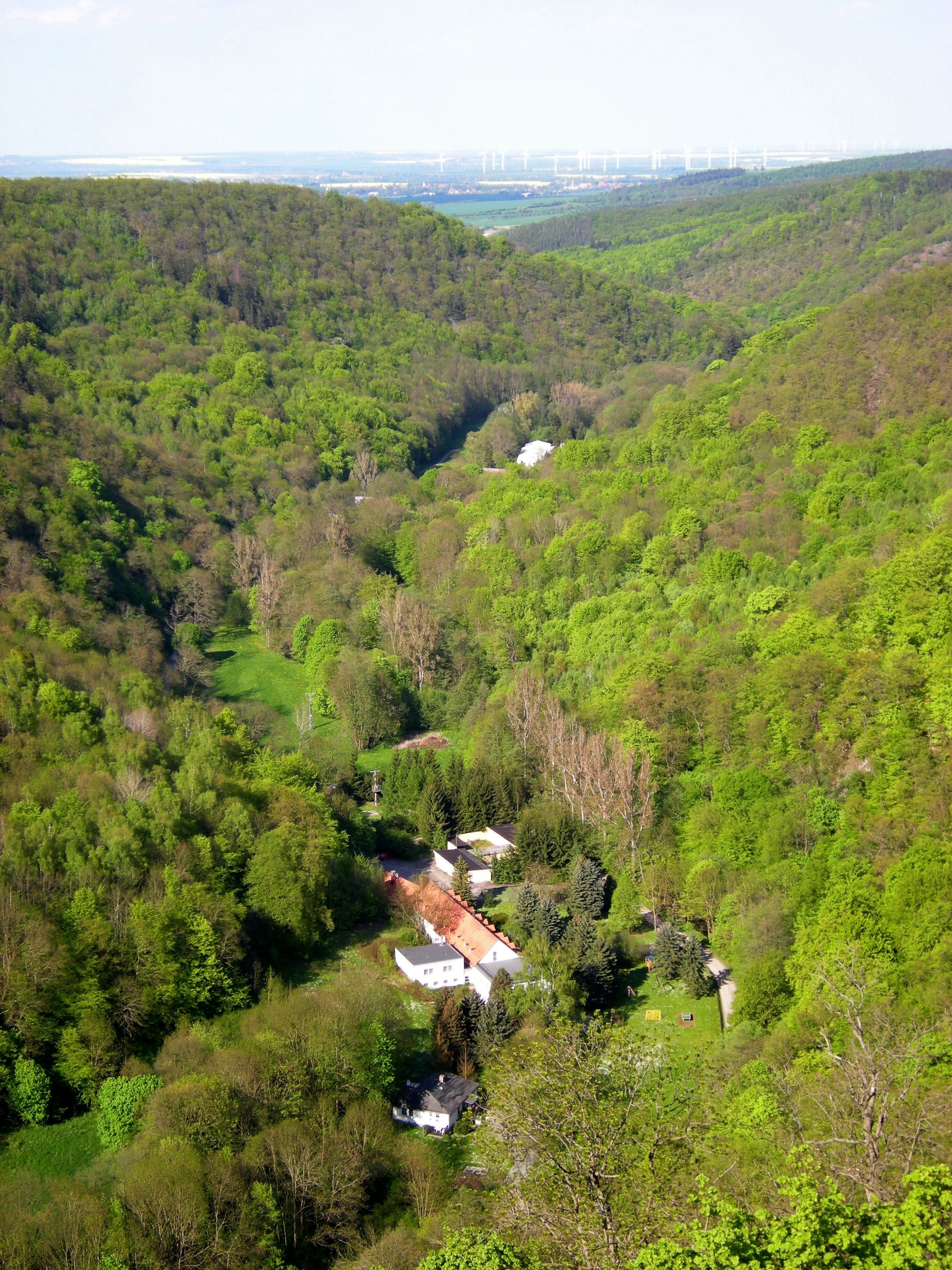|
Pansfelde
Pansfelde is a village in the town of Falkenstein/Harz in the district of Harz in Saxony-Anhalt, Germany. Geography Pansfelde lies in the southeastern part of the district of Harz and next to the neighbouring districts of Mansfeld-Südharz and Salzlandkreis on the heights of the Lower Harz plateau, an agricultural upland surrounded by woods. The countryside between the wayside stations of Leinemühle and Gartenhaus, a road toll known as ''chausseegeld'' was collected in former times, consists of mixed woods, farmland and pastures in the Schwennecke valley. History Pansfelde was first mentioned in 1276 under the name of ''Pamesvelde''. The history of the village and its inhabitants is closely tied to that of Falkenstein Castle. The ancestors of the present 570 or so population worked at the castle, defended it, worked as farm hands or foresters or in the mills and helped during the hunts. On 1 January 2002 Pansfelde joined the town of Ermsleben and five other villages to f ... [...More Info...] [...Related Items...] OR: [Wikipedia] [Google] [Baidu] |
Ermsleben
Falkenstein/Harz is a town in the Harz district, in Saxony-Anhalt, Germany. It was created in 2002 by merging the town of Ermsleben with the former municipalities of Endorf, Meisdorf, Neuplatendorf, Pansfelde, Reinstedt und Wieserode. The new community was named after Falkenstein Castle. Geography The town is situated on the northeastern edge of the Harz mountain range, about west of Aschersleben. The municipal area stretches from the lower Selke valley down to the northern Harz foothills. Reinstedt, Ermsleben and Meisdorf were stops on the Frose–Quedlinburg railway line which was closed in 2004. Falkenstein Castle is a point on the southern route of the Romanesque Road. Until the Saxony-Anhalt administrative reform of 2007, Falkenstein belonged to Aschersleben-Staßfurt district. History While the settlements of Endorf, Reinstedt and Wieserode in the Saxon Schwabengau were already mentioned in the 10th century, Ermsleben is documented as ''Anegremislebo'' in a 1045 d ... [...More Info...] [...Related Items...] OR: [Wikipedia] [Google] [Baidu] |
Falkenstein/Harz
Falkenstein/Harz is a town in the Harz district, in Saxony-Anhalt, Germany. It was created in 2002 by merging the town of Ermsleben with the former municipalities of Endorf, Meisdorf, Neuplatendorf, Pansfelde, Reinstedt und Wieserode. The new community was named after Falkenstein Castle. Geography The town is situated on the northeastern edge of the Harz mountain range, about west of Aschersleben. The municipal area stretches from the lower Selke valley down to the northern Harz foothills. Reinstedt, Ermsleben and Meisdorf were stops on the Frose–Quedlinburg railway line which was closed in 2004. Falkenstein Castle is a point on the southern route of the Romanesque Road. Until the Saxony-Anhalt administrative reform of 2007, Falkenstein belonged to Aschersleben-Staßfurt district. History While the settlements of Endorf, Reinstedt and Wieserode in the Saxon Schwabengau were already mentioned in the 10th century, Ermsleben is documented as ''Anegremislebo'' in a 1045 d ... [...More Info...] [...Related Items...] OR: [Wikipedia] [Google] [Baidu] |
Falkenstein, Saxony-Anhalt
Falkenstein/Harz is a town in the Harz district, in Saxony-Anhalt, Germany. It was created in 2002 by merging the town of Ermsleben with the former municipalities of Endorf, Meisdorf, Neuplatendorf, Pansfelde, Reinstedt und Wieserode. The new community was named after Falkenstein Castle. Geography The town is situated on the northeastern edge of the Harz mountain range, about west of Aschersleben. The municipal area stretches from the lower Selke valley down to the northern Harz foothills. Reinstedt, Ermsleben and Meisdorf were stops on the Frose–Quedlinburg railway line which was closed in 2004. Falkenstein Castle is a point on the southern route of the Romanesque Road. Until the Saxony-Anhalt administrative reform of 2007, Falkenstein belonged to Aschersleben-Staßfurt district. History While the settlements of Endorf, Reinstedt and Wieserode in the Saxon Schwabengau were already mentioned in the 10th century, Ermsleben is documented as ''Anegremislebo'' in a 1045 d ... [...More Info...] [...Related Items...] OR: [Wikipedia] [Google] [Baidu] |
Old Falkenstein Castle
Old Falkenstein Castle (german: Burg Alter Falkenstein or ''Burg Alt-Falkenstein'') in the Harz Mountains of Germany is the castle site or ''burgstall'' of a high medieval hill castle. It lies on the territory of Falkenstein/Harz in the state of Saxony-Anhalt in the district of Harz. It was built in the 11th century A.D. and destroyed in 1115. Location The ruins of Old Falkenstein are located in the eastern Harz region of Mansfeld Land between Mägdesprung (north of Harzgerode) and Meisdorf (southwest of Falkenstein/Harz) on a rocky ridge () above the valley of the River Selke. In the forested landscape of the Harz/Saxony-Anhalt Nature Park, it lies within the nature reserve of ''Selketal'' ("Selke Valley") about northwest of the ''Köhlerhütte'', [...More Info...] [...Related Items...] OR: [Wikipedia] [Google] [Baidu] |
Gutsbezirk Degenershausen
The Degenershausen Estate (german: Gutsbezirk Degenershausen) was established in 1872 in accordance with the Prussian County Act of 1872 as an independent municipal estate together with a manor house. In 1928 the municipal estate was disbanded by an act of 27 December 1927. The estate then belonged to the municipality of Wieserode, now a village in the borough of Falkenstein, Harz county in the German state of Saxony-Anhalt. The owner of the estate during this period were ''Fideikommissherren'' Hans-Heinrich Freiherr von Bodenhausen-Degener (1839–1912), Eberhard Freiherr von Bodenhausen-Degener (1868–1918) and Hans Wilke Freiherr von Bodenhausen-Degener (1901–1937). The estate figured in the Allied discovery of the Marburg Files as World War II World War II or the Second World War, often abbreviated as WWII or WW2, was a world war that lasted from 1939 to 1945. It involved the vast majority of the world's countries—including all of the great powers—for ... [...More Info...] [...Related Items...] OR: [Wikipedia] [Google] [Baidu] |
House Of Anhalt
The House of Ascania (german: Askanier) was a dynasty of German rulers. It is also known as the House of Anhalt, which refers to its longest-held possession, Anhalt. The Ascanians are named after Ascania (or Ascaria) Castle, known as ''Schloss Askanien'' in German, which was located near and named after Aschersleben. The castle was the seat of the County of Ascania, a title that was later subsumed into the titles of the princes of Anhalt. History The earliest known member of the house, Esiko, Count of Ballenstedt, first appears in a document of 1036. He is assumed to have been a grandson (through his mother) of Odo I, Margrave of the Saxon Ostmark. From Odo, the Ascanians inherited large properties in the Saxon Eastern March. Esiko's grandson was Otto, Count of Ballenstedt, who died in 1123. By Otto's marriage to Eilika, daughter of Magnus, Duke of Saxony, the Ascanians became heirs to half of the property of the House of Billung, former dukes of Saxony. Otto's son, Alb ... [...More Info...] [...Related Items...] OR: [Wikipedia] [Google] [Baidu] |
Anhalt Castle
Anhalt Castle (german: Burg Anhalt) is a ruined medieval fortification near the town of Harzgerode in Saxony-Anhalt, Germany. Location The castle is located in the eastern, lower part of the Harz mountain range (''Unterharz''). The ruins stand on the Großer Hausberg, a hill situated between the villages of Meisdorf and Mägdesprung, above the Selke valley. The area is part of the Harz/Saxony-Anhalt Nature Park; at a short distance up the Selke river is the preserved Falkenstein Castle. History The fortress was probably built by Count Otto of Ballenstedt (d. 1123), a member of the Saxon noble House of Ascania. Otto's grandfather Count Esico, mentioned in a 1036 deed issued by Emperor Conrad II, had ruled in the Saxon ''Schwabengau'' and the adjacent territories of the Saxon Eastern March. Otto assumed comital rights in Saxony after the assassination of his father Count Adalbert II in 1080; he married Eilika, the daughter of Duke Magnus of Saxony, and launched several campai ... [...More Info...] [...Related Items...] OR: [Wikipedia] [Google] [Baidu] |
Listed Building
In the United Kingdom, a listed building or listed structure is one that has been placed on one of the four statutory lists maintained by Historic England in England, Historic Environment Scotland in Scotland, in Wales, and the Northern Ireland Environment Agency in Northern Ireland. The term has also been used in the Republic of Ireland, where buildings are protected under the Planning and Development Act 2000. The statutory term in Ireland is " protected structure". A listed building may not be demolished, extended, or altered without special permission from the local planning authority, which typically consults the relevant central government agency, particularly for significant alterations to the more notable listed buildings. In England and Wales, a national amenity society must be notified of any work to a listed building which involves any element of demolition. Exemption from secular listed building control is provided for some buildings in current use for worship, ... [...More Info...] [...Related Items...] OR: [Wikipedia] [Google] [Baidu] |
Timber-framed
Timber framing (german: Holzfachwerk) and "post-and-beam" construction are traditional methods of building with heavy timbers, creating structures using squared-off and carefully fitted and joined timbers with joints secured by large wooden pegs. If the structural frame of load-bearing timber is left exposed on the exterior of the building it may be referred to as half-timbered, and in many cases the infill between timbers will be used for decorative effect. The country most known for this kind of architecture is Germany, where timber-framed houses are spread all over the country. The method comes from working directly from logs and trees rather than pre-cut dimensional lumber. Hewing this with broadaxes, adzes, and draw knives and using hand-powered braces and augers (brace and bit) and other woodworking tools, artisans or framers could gradually assemble a building. Since this building method has been used for thousands of years in many parts of the world, many styles ... [...More Info...] [...Related Items...] OR: [Wikipedia] [Google] [Baidu] |
Statistisches Bundesamt
The Federal Statistical Office (german: Statistisches Bundesamt, shortened ''Destatis'') is a federal authority of Germany. It reports to the Federal Ministry of the Interior. The Office is responsible for collecting, processing, presenting and analysing statistical information concerning the topics economy, society and environment. The purpose is providing objective, independent and highly qualitative statistical information for the whole public. About 2300 staff members are employed in the departments in Wiesbaden, Bonn and Berlin. The department in Wiesbaden is the main office and runs the largest library specialised in statistical literature in Germany. It is also the Office of the President who is also by tradition, but not by virtue of the office, the Federal Returning Officer. In this position, they are the supervisor of the elections of the German Parliament ("Bundestag") and of the European Parliament. The Berlin Information Point is the service centre of the Federal O ... [...More Info...] [...Related Items...] OR: [Wikipedia] [Google] [Baidu] |





